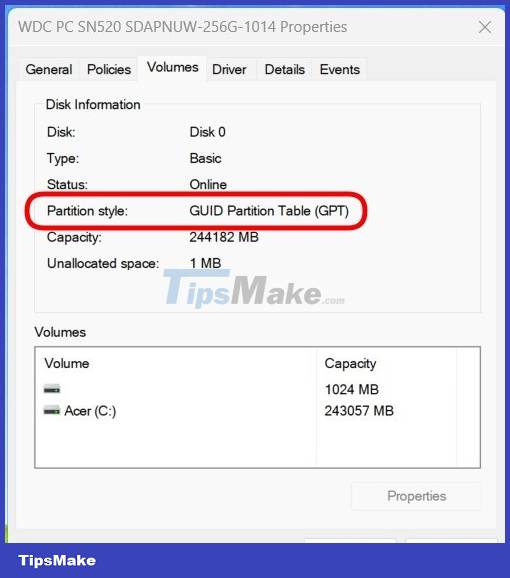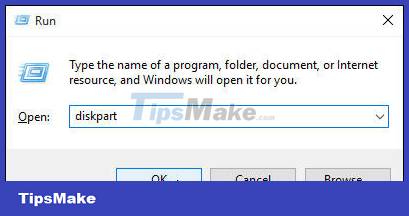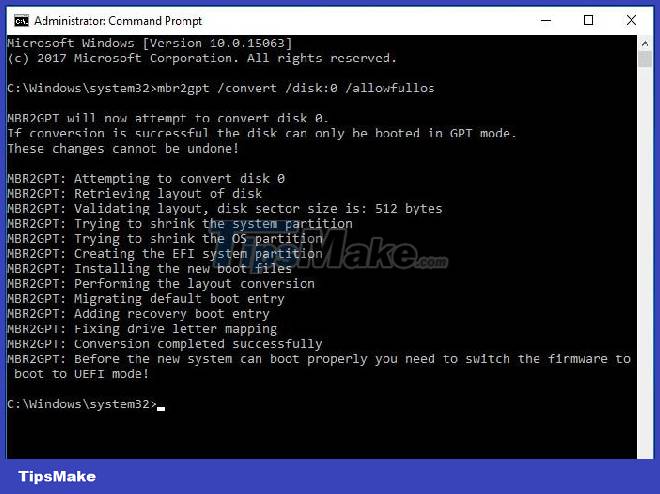Convert MBR to GPT on Windows drive
One advantage of GPT is that you have more than 4 partitions per drive. Drives larger than 2TB also require GPT because the MBR does not support sizes larger than this.
You can change the drive from MBR to GPT as long as the drive doesn't have a partition (partition or volume). GPT partitioning cannot be used on removable storage devices or with cluster drives, connecting to a shared SCSI or Fiber Channel bus used by Cluster services.
Note:
- Before converting drives, turn off all programs running on the drive.
- You must be a member of the Backup Operators or Administrators group to perform the next steps.
How to check if your drive is MBR or GPT
Of course, before proceeding to convert MBR to GPT, you must determine what format your drive is in. The steps are as follows:
Step 1 : Click Start.
Step 2 : Search for Disk Management and click on the first search result.

Step 3 : Right-click on the drive (where Windows is installed) and then select Properties.

Step 4 : Click on the Volumes tab.
Step 5 : In the " Partition styles " section, if you see GUID Partition Table (GPT) , it means that your drive does not need to be converted anymore. If you see Master Boot Record (MBR) , then you should start the conversion process.

Step 6 : Click the Cancel button to proceed to the next steps.
Convert MBR to GPT using Windows interface
Step 1 - Backup or transfer the data on the MBR drive you want to convert.
Step 2 - If the drive has a partition, right-click and select Delete Partition or Delete Volume.
Step 3 - Right-click on the MBR drive you want to convert, then select Convert to GPT Disk .
Convert MBR drive to GPT using command line interface
Step 1 - Backup or transfer the data on the MBR drive you want to convert.
Step 2 - Open the command line interface with administrative rights by right-clicking on Command Prompt and selecting Run as Administrator.

Step 3 - Type diskpartIf the drive has no partitions, go to step 6.
Step 4 - At the DISKPART command window , type list disk, write down the number of drives you want to convert.
Step 5 - At the DISKPART command window , type select disk .
Step 6 - At the DISKPART command window , typeclean.
Note : Running the command cleanwill delete all partitions on the drive.
Step 7 - At the DISKPART command window , type convert gpt.

So you have completed the steps to convert the drive from MBR to GPT. Below is an explanation of the values mentioned in the article.
| Value | Describe |
| list disk | Displays a list of drives with information about them such as size, free space, Basic or Dynamic drives, using MBR or GPT partitioning. Drives marked with an asterisk (*) are using the GPT partition type. |
| select disk (disknumber) | select the drive, where disknumber is the drive's number. |
| clean | delete all partitions on the selected drive. |
| convert gpt | converts Basic drive with MBR partition type to Basic drive with GPT partition type. |
The above method applies to Windows 10, Windows 8.1, Windows Server (Semi-Annual Channel), Windows Server 2016, Windows Server 2012 R2, Windows Server 2012.
Convert MBR to GPT with MBR2GPT . tool
If you are using Windows 10 v1703 or later operating system, MBR2GPT.exe will be a useful choice to convert from MBR to GPT. Here's how to convert MBR to GPT with MBR2GPT.
Note : Since the program to convert MBR to GPT drives is available in both Windows PE and full operating system environments, the command will be different.
In WinPE, type:
mbr2gpt /convert /disk: nIn Windows 10, type:
mbr2gpt /convert /disk: n /allowfullOSWhere N is the drive number.

Warning :
Before trying to convert a drive from MBR to GPT, make sure your computer supports UEFI booting.
After converting the OS drive to GPT, please reconfigure the firmware to boot to UEFI mode instead of Legacy BIOS.
MBR2GPT conversion failed
In most cases, MBR2GPT can work properly. However, sometimes you can run into problems. After entering the MBR2GPT allowfullos command line above, you may be bothered by the failure of the MBR2GPT drive layout validation, which is due to unsupported versions of Windows 10.
For example, if you use this tool to convert MBR to GPT in Windows 10 v1607, the error message 'LayoutConversion: Layout conversion failed. Error: 0x00000032[gle=0x00000032]; Cannot perform layout conversion. Error: 0x00000032[gle=0x00000032]' will appear.
This method requires you to run your PC from Windows 10 v1703 or later and perform the conversion offline, as mentioned above.
In addition, you may encounter a situation where MBR2GPT cannot find the operating system partition. This is because the tool is only used to convert any MBR to GPT formatted system drive and it cannot work for data drives on which the operating system is not installed.
In addition, some other problems such as MBR2GPT not being recognized, MBR2GPT not being able to retrieve the drive geometry, etc. may also appear.
Convert MBR to GPT with EaseUS Partition Software
The last option to convert MBR to GPT without data loss is to use EaseUS Partition Master Professional. Some people may find this easier than converting using MBR2GPT, which uses a similar user interface to the Windows Disk Management screen. Furthermore, EaseUS Partition Software has several additional options, one of which is a MBR to GPT converter.
However, you will have to pay $39.95 for EaseUS Partition Master Professional, while the built-in Windows MBR2GPT tool is free, as it is part of the operating system.
1. Go to the EaseUS Partition Master website. Buy software, download and install. (Tip: If you're only converting one drive, get the trial version.)
2. Open EaseUS Partition Master and wait for your drive to load. Next, locate the drive you want to convert. Select the drive, right click and select Convert MBR to GPT .
3. Click the Apply button on the toolbar. After you press Apply , the system will reboot. You will come to the EaseUS Partition Master activity screen, showing the conversion in progress.
4. You need to change your firmware to boot to UEFI mode. After the system reboots, press the key to enter BIOS/UEFI. Change the boot type to UEFI mode, as opposed to Legacy Mode or other equivalent modes.
So EaseUS Partition Master makes the MBR to GPT conversion easy but slightly slower than the free Microsoft option.
What is the difference between MBR and GPT?
First, consider the difference between MBR and GPT and why some systems use MBR instead of GPT and vice versa.
MBR
MBR is an older version than GPT and is therefore compatible with a wider range of systems. MBR was developed for IBM computers and has, therefore, been the primary partition table choice for Windows machines for quite some time. The Master Boot Record gets its name due to its location at the top of the hard drive, containing the bootloader for the operating system and information about the drive partitions.
MBR only works with drives up to 2TB in size. Furthermore, an MBR drive can only have 4 primary partitions. This was fine when a 2TB drive came at a premium, but now you can pick up an 8TB drive, like the Seagate Barracuda, for an affordable price.
GPT
GPT is a newer option than MBR. GPT is closely linked with UEFI, the modern firmware solution that replaces the old version, BIOS. The GUID partition table assigns every partition on the drive a unique identifier (GUID). A 128-bit number will identify your hardware (a 128-bit integer has a maximum value of 1.7 x 10^39 - an extraordinarily large number).
GPT drives suffer from some of the limitations of MBR drives. GPT drives can be a lot larger than MBR drives (with the right settings, a theoretical 256TB drive should work). On Windows systems, a GPT drive can have up to 128 different partitions without using an extended partition. Other systems allow even more than that.
Another big difference is how the GPT drive stores the boot data. Unlike MBR drives, GPT drives store multiple copies of boot data across multiple partitions, making recovery much easier.
Compatibility
Not all versions of Windows can boot from a GPT partitioned drive, many require a UEFI-based system.
- Windows 11, 10, 8/8.1, 7 and Vista 64-bit all require a UEFI-based system to boot from a GPT drive.
- Windows 10 and 8/8.1 32-bit require a UEFI-based system to boot from a GPT drive. There is no 32-bit version for Windows 11.
- Windows 7 and Vista 32-bit cannot boot from a GPT drive.
- All Windows versions mentioned can read and write to GPT drives.
Other operating systems also use the GPT system. For example, Apple now uses GPT instead of Apple Partition Table (APT). Furthermore, Linux has built-in support for GPT drives.
The launch of Windows 11 in 2021 has forced many users to switch existing drive partitions from MBR to GPT. Windows 11 will only boot from a UEFI GPT drive, which has caused some problems for users trying to make the switch.
You've now successfully converted your old MBR drive into a GPT drive, giving you more control over how you use your drive. After converting the partition table and switching from BIOS to UEFI, you will find that you also have more control over the system firmware. After all, that was one of the main reasons UEFI was introduced, to allow greater control and provide more advanced options over hardware.
You should read it
- How to transfer Windows to an SSD without reinstalling
- Convert MBR to GPT with no data loss
- How to convert Excel files to PDF online using Google Drive
- Convert PDF to Word, convert PDF files for free
- How to fix 'The disk selected has an MBR partition table' when installing Windows
- How to Convert MBR to GPT Disk with AOMEI Partition Assistant
- How to convert a GPT hard drive format to an MBR while installing Win with the CMD command
- How to convert PNG images to JPG does not degrade quality
May be interested
- How to convert image file to PDF on Windows 10
 to convert the image file format to a pdf file on windows 10, we can immediately use the transfer mode available on the system without having to install the software.
to convert the image file format to a pdf file on windows 10, we can immediately use the transfer mode available on the system without having to install the software. - How to Convert PDF to JPG
 this article shows you how to convert pdf files into a series of images in jpg format. although the windows operating system does not have this utility built-in, you can use the application in the windows 10 app store to convert pdf files. mac users can use preview software to convert pdf to jpg format. you can also use adobe acrobat pro if you have paid to use this software.
this article shows you how to convert pdf files into a series of images in jpg format. although the windows operating system does not have this utility built-in, you can use the application in the windows 10 app store to convert pdf files. mac users can use preview software to convert pdf to jpg format. you can also use adobe acrobat pro if you have paid to use this software. - Convert PDF to Office without using software
 one pretty neat way is to use comedocs pdf converter, an extension for google chrome that has the added functionality of google drive to convert pdf files to office formats quickly and easily. you won't need to install any software on windows.
one pretty neat way is to use comedocs pdf converter, an extension for google chrome that has the added functionality of google drive to convert pdf files to office formats quickly and easily. you won't need to install any software on windows. - How to Convert Word Files to PDF Format
 this article shows you how to convert microsoft word documents to pdf format. pdf files are compatible with almost any interface and are difficult to edit, suitable for storing and sending important documents. you can use smallpdf or google drive to convert word documents to pdf format online, or use microsoft word on a windows or mac computer.
this article shows you how to convert microsoft word documents to pdf format. pdf files are compatible with almost any interface and are difficult to edit, suitable for storing and sending important documents. you can use smallpdf or google drive to convert word documents to pdf format online, or use microsoft word on a windows or mac computer. - How to convert WAV format to MP3 using LAME with Audacity
 audacity is a free audio editing software that has some impressive features and is easy to use. audacity is compatible with some operating systems like windows, mac and linux.
audacity is a free audio editing software that has some impressive features and is easy to use. audacity is compatible with some operating systems like windows, mac and linux. - How to set up the Windows Store app installation to any D drive or drive
 how to set up the windows store app installation to any d drive or drive. unlike normal software, you can choose where to install applications to easily manage data or edit as needed, windows store when downloading always automatically installs directly to the windows drive on the computer system .
how to set up the windows store app installation to any d drive or drive. unlike normal software, you can choose where to install applications to easily manage data or edit as needed, windows store when downloading always automatically installs directly to the windows drive on the computer system . - How to convert HEIC images to JPG / PNG
 heic is an image format on ios devices so users on windows will have trouble using it. so you can transfer heic files to jpg or png on your computer.
heic is an image format on ios devices so users on windows will have trouble using it. so you can transfer heic files to jpg or png on your computer. - How to convert PowerShell script file (.ps1) to .exe by IExpress on Windows 10
 normally, a powershell script file with the .ps1 extension needed cannot be executed by double-clicking. to execute, you will have to access powershell and write an activation command. for ease of use, you can convert .ps1 files to .exe files.
normally, a powershell script file with the .ps1 extension needed cannot be executed by double-clicking. to execute, you will have to access powershell and write an activation command. for ease of use, you can convert .ps1 files to .exe files. - The convert in Windows command
 the convert command converts file allocation table (fat) and fat32 to the ntfs file system, keeping existing files and folders intact. the drives that have been converted to ntfs file systems cannot be converted to fat or fat32 anymore.
the convert command converts file allocation table (fat) and fat32 to the ntfs file system, keeping existing files and folders intact. the drives that have been converted to ntfs file systems cannot be converted to fat or fat32 anymore. - How to transfer space from drive D to drive C on Windows 11
 transferring capacity from drive d to drive c on windows 11 is an effective solution when drive c is full, affecting computer performance. in this article, software tips will guide you on how to transfer capacity between partitions safely and accurately.
transferring capacity from drive d to drive c on windows 11 is an effective solution when drive c is full, affecting computer performance. in this article, software tips will guide you on how to transfer capacity between partitions safely and accurately.










 Windows + V: Useful keyboard shortcuts that many Windows users don't know
Windows + V: Useful keyboard shortcuts that many Windows users don't know There is a new version of Windows every 3 years, Windows 12 coming out in 2024?
There is a new version of Windows every 3 years, Windows 12 coming out in 2024? How to Get Google Play Store on Amazon Fire
How to Get Google Play Store on Amazon Fire Windows 11 has caught up with Windows 10 in terms of performance
Windows 11 has caught up with Windows 10 in terms of performance Is Linux, Windows or macOS the operating system for you?
Is Linux, Windows or macOS the operating system for you? OneDrive is about to become the default folder in File Explorer on Windows 11
OneDrive is about to become the default folder in File Explorer on Windows 11